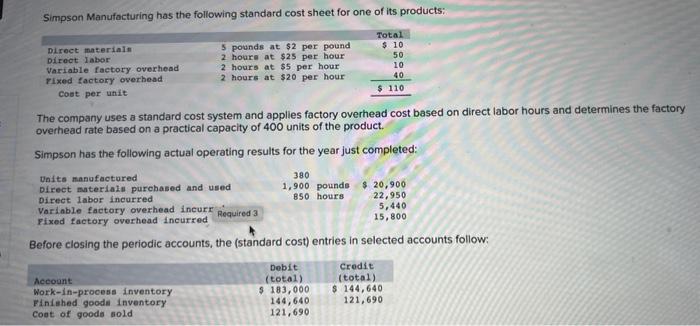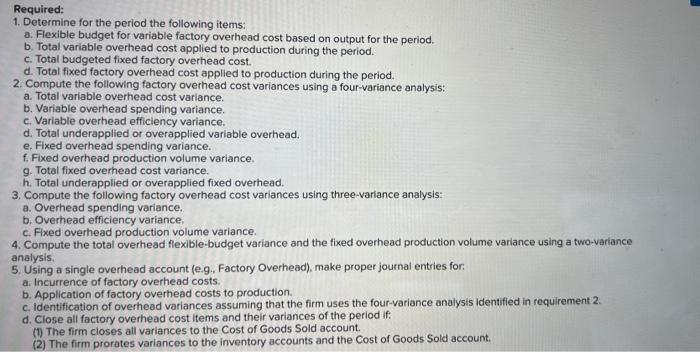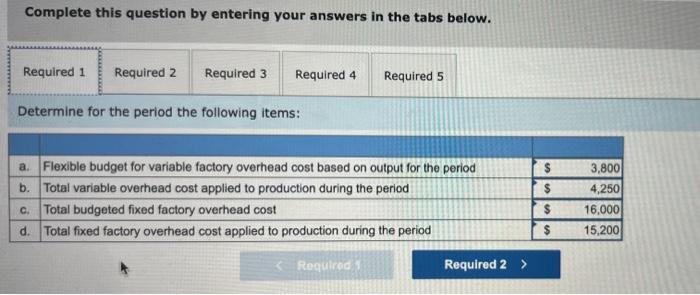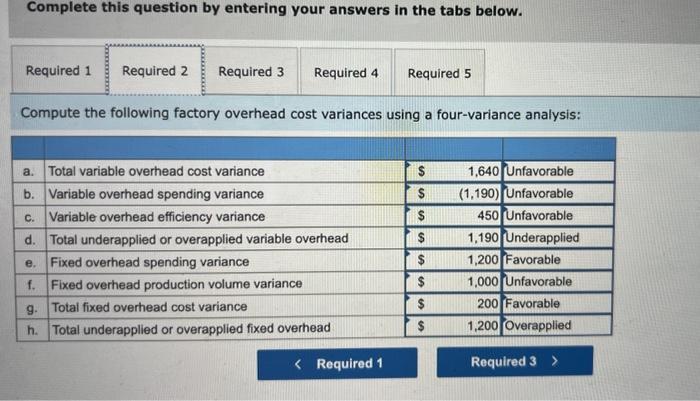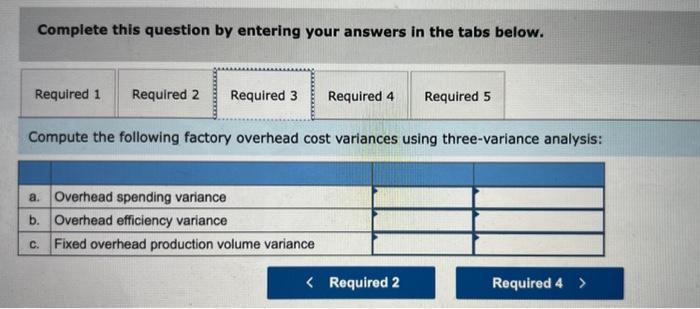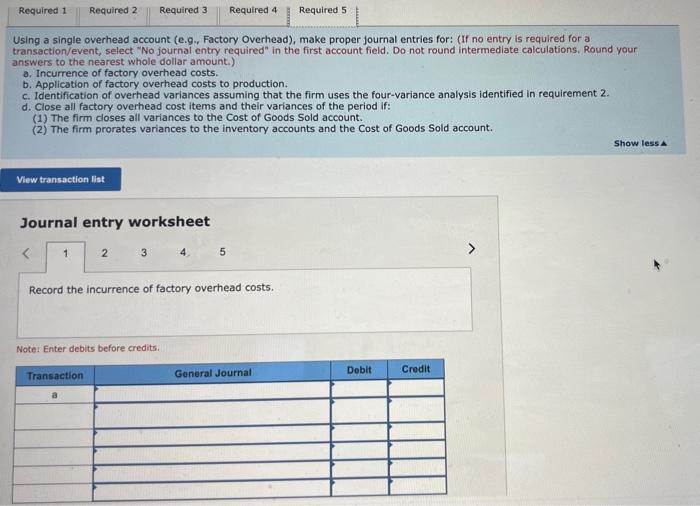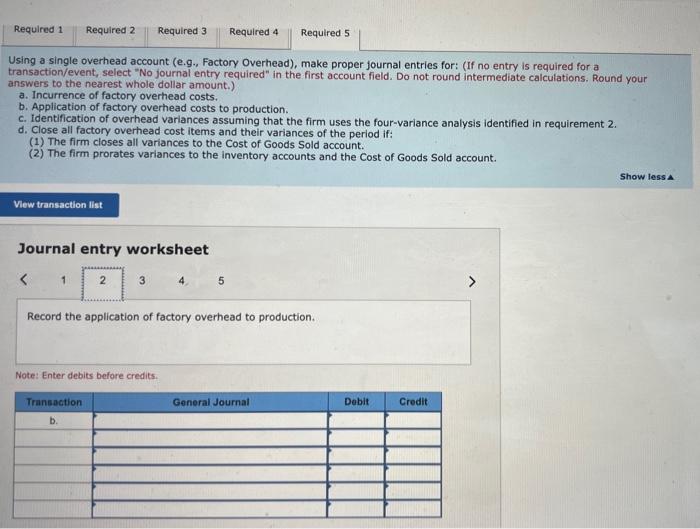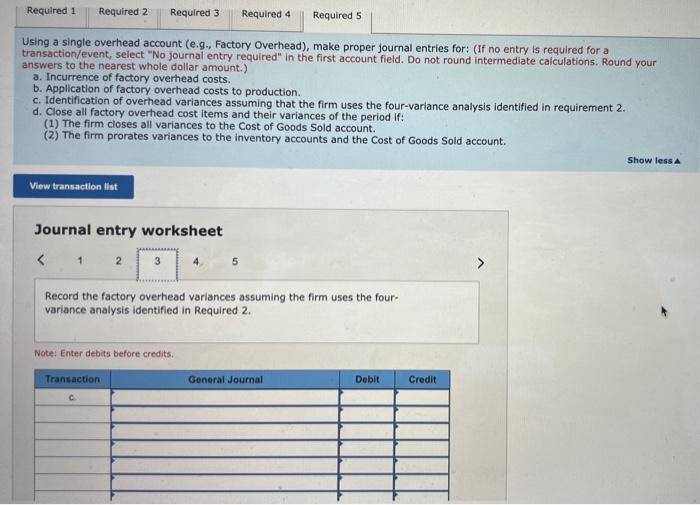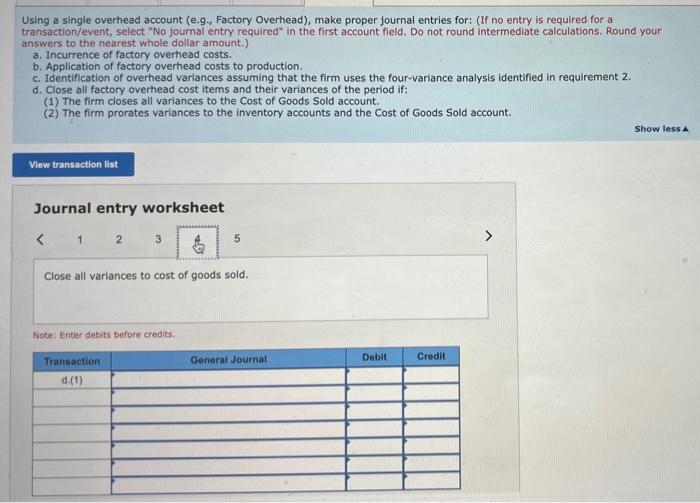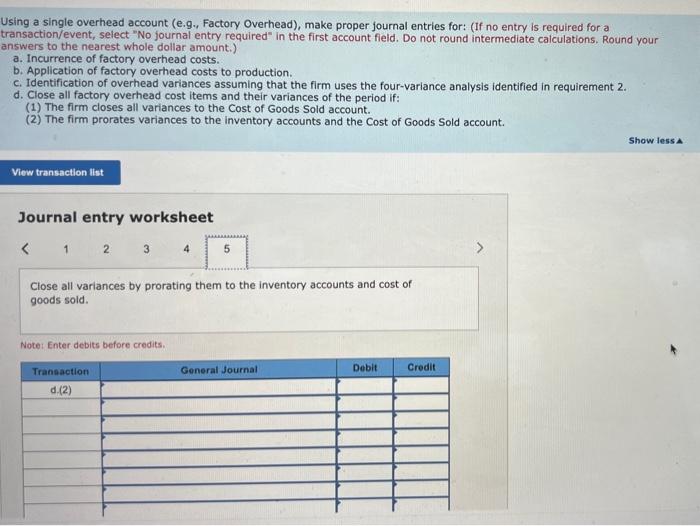Simpson Manufacturing has the following standard cost sheet for one of its products: The company uses a standard cost system and applies factory overhead cost based on direct labor hours and determines the factory overhead rate based on a practical capacity of 400 units of the product. Simpson has the following actual operating results for the year just completed: Before closing the periodic accounts, the (standard cost) entries in selected accounts follow: Required: 1. Determine for the period the following items: a. Flexible budget for variable factory overhead cost based on output for the period. b. Total variable overhead cost applied to production during the period. c. Total budgeted fixed factory overhead cost. d. Total fixed factory overhead cost applied to production during the period. 2. Compute the following factory overhead cost variances using a four-variance analysis: a. Total variable overhead cost variance. b. Variable overhead spending variance. c. Variable overhead efficiency variance. d. Total underapplied or overapplied variable overhead. e. Fixed overhead spending variance. f. Fixed overhead production volume variance. 9. Total fixed overhead cost variance. h. Total underapplied or overapplied fixed overhead. 3. Compute the following factory overhead cost variances using three-variance analysis: a. Overhead spending variance. b. Overhead efficiency variance. c. Fixed overhead production volume variance. 4. Compute the total overhead flexible-budget variance and the fixed overhead production volume variance using a two-variance analysis. 5. Using a single overhead account (e.g. Factory Overhead), make proper journal entries for: a. Incurrence of factory overhead costs. b. Application of factory overhead costs to production. c. Identification of overhead variances assuming that the firm uses the four-variance analysis identified in requirement 2. d. Close all factory overhead cost items and their variances of the period if: (1) The firm closes all variances to the Cost of Goods Sold account. (2) The firm prorates variances to the inventory accounts and the Cost of Goods Sold account. Complete this question by entering your answers in the tabs below. Determine for the period the following items: Complete this question by entering your answers in the tabs below. Compute the following factory overhead cost variances using a four-variance analysis: Complete this question by entering your answers in the tabs below. Compute the following factory overhead cost variances using three-variance analysis Complete this question by entering your answers in the tabs below. Compute the total overhead flexible-budget variance and the fixed overhead production volume variance using a two-variance analysis. Using a single overhead account (e.g., Factory Overhead), make proper journal entries for: (If no entry is required for a transaction/event, select "No journal entry required" in the first account field. Do not round intermediate calculations, Round your answers to the nearest whole dollar amount.) a. Incurrence of factory overhead costs. b. Application of factory overhead costs to production. c. Identification of overhead variances assuming that the firm uses the four-variance analysis identified in requirement 2 . d. Close all factory overhead cost items and thelr variances of the period if: (1) The firm closes all variances to the Cost of Goods Sold account. (2) The firm prorates variances to the inventory accounts and the Cost of Goods Sold account. Journal entry worksheet 2 4. 5 Record the incurrence of factory overhead costs. Note: Enter debits before credits. Using a single overhead account (e.g., Factory Overhead), make proper journal entries for: (If no entry is required for a transaction/event, select "No journal entry required" in the first account field. Do not round intermediate calculations. Round your answers to the nearest whole dollar amount.) a. Incurrence of factory overhead costs. b. Application of factory overhead costs to production. c. identification of overhead variances assuming that the firm uses the four-variance analysis identified in requirement 2. d. Close all factory overhead cost items and their variances of the period if: (1) The firm closes all variances to the Cost of Goods Sold account. (2) The firm prorates variances to the inventory accounts and the Cost of Goods Sold account. Journal entry worksheet 5 Record the application of factory overhead to production. Note: Enter debits before credits. Using a single overhead account (e.g., Factory Overhead), make proper journal entries for: (If no entry is required for a transaction/event, select "No journal entry required" in the first account field. Do not round intermediate calculations. Round your answers to the nearest whole doliar amount.) a. Incurrence of factory overhead costs. b. Application of factory overhead costs to production. c. Identification of overhead variances assuming that the firm uses the four-variance analysis identified in requirement 2. d. Close all factory overhead cost items and their variances of the period if: (1) The firm closes all variances to the Cost of Goods Sold account. (2) The firm prorates variances to the inventory accounts and the Cost of Goods Sold account. Journal entry worksheet Record the factory overhead variances assuming the firm uses the fourvariance analysis identified in Required 2. Note: Enter debits before credits. Using a single overhead account (e.g., Factory Overhead), make proper journal entries for: (If no entry is required for a transaction/event, select "No journal entry required" in the first account field. Do not round intermediate calculations. Round your answers to the nearest whole dollar amount.) a. Incurrence of factory overhead costs. b. Application of factory overhead costs to production. c. Identification of overhead variances assuming that the firm uses the four-variance analysis identified in requirement 2. d. Close all factory overhead cost items and their variances of the period if: (1) The firm closes all variances to the Cost of Goods Sold account. (2) The firm prorates variances to the inventory accounts and the Cost of Goods Sold account. Journal entry worksheet
